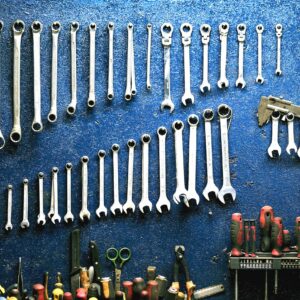How to Keep Tools From Rusting

How to Keep Tools From Rusting
Tools, like everything else, are more expensive these days than ever. Knowing how to keep tools from rusting is important for people who want to protect their investment and ensure their tools are in great shape for years to come.
This is especially true for high-quality tools, which can get pricey. People buy more expensive tools with the intention they’ll not only be more efficient and safer for the job but also hoping they’ll last longer. Taking a few extra steps to prevent corrosion can make a big difference. Using vapor corrosion inhibitors is one of those.
Tools Prone to Rust and Corrosion
Rust is a type of corrosion that kicks off in the presence of oxygen and moisture. It’s an electrochemical reaction specific to iron and iron alloys (including steel). The reddish-brown color the result of iron oxide, which is when iron loses electrons to oxygen. The presence of elements like oil or sweat from hands, salty air, humidity, or vastly fluctuating temperatures can accelerate the corrosive process.
Rust risk for tools varies depending on their composition/type of metal, design, and usage patterns. Tools that have exposed metal surfaces and those that are used in outdoor or damp environments are going to be more prone to rusting. These include hand tools, garden tools, and certain power tools with intricate metal parts. Tools that have irregular shapes and tough-to-reach areas can also trap moisture and be more susceptible to corrosion.
As rust prevention experts, we know some higher end tools have special coatings or other treatments to help halt corrosion. However, very few metal tools are wholly immune to the risk of rust and corrosion, particularly the more use they get.
Types of tools most susceptible to rust include:
- Hand tools. Those with metal components like wrenches, pliers, and screwdrivers are vulnerable to rust. They often have exposed surfaces that might come into direct contact with moisture.
- Garden tools. Pruning shears, hoes, and shovels are exposed to water, soil, and hand sweat. Outdoor storage can exacerbate the risk.
- Power tools. Some power tools like electric saws, drills, and grinders may have components that can rust.
- Automotive tools. Tools that are used in car maintenance (sockets, wrenches, and jacks) are often exposed to fluids and other elements that may be corrosive.
- Metalworking tools. Tools that are used in metal fabrication, like chisels, metal saws, and files, are exposed to the corrosive impacts of cutting fluids and metal shavings in addition to oxygen and humidity.
Preventing Tool Rust With VCIs
Rust is more than an aesthetics issue. It can compromise the safety and effectiveness of your tools. But rather than searching for a tool rust remover once you already have a problem, prioritizing rust prevention is important.
In addition to taking care to regularly clean and dry tools and store them in a cool, dry place, tool owners can use VCI products to slash the risk of rust while they’re being stored.
VCIs, short for Vapor Corrosion Inhibitors, have emerged as effective solutions for those wanting to know how to keep tools from rusting.
They work by releasing molecules into the air that form a protective layer around the metal surface, preventing corrosive elements from making direct contact with the metal. Inhibitor molecules adhere to the metal surface and, though a process called volatilization, the inhibitors vaporize and form a protective layer that blocks electrochemical reactions that lead to rust formation.
VCI rust prevention products come in various forms: Powders, papers, films, and emitters. At Zerust, we primarily use emitters, woven into things like tool box drawer liners, vapor capsules, multi-purpose VCI polybags, table saw covers, and Plastabs. VCIs are non-toxic, odorless, and leave no residue – making them a user-friendly option for tool preservation.
*************@************ts.com“>Contact Zerust for information on tool rust prevention by emailing us or calling (330) 405-1965.
Additional Resources:
8 Tool Maintenance Tips You Need to Follow, Oct. 27, 2023, By Harrison Kral, Family Handyman
More Blog Entries:
Choose a Table Saw Cover That Offers Rust & Corrosion Prevention, Oct. 23, 2023, How to Keep Tools From Rusting
- Categorized: Rust Prevention Tips





